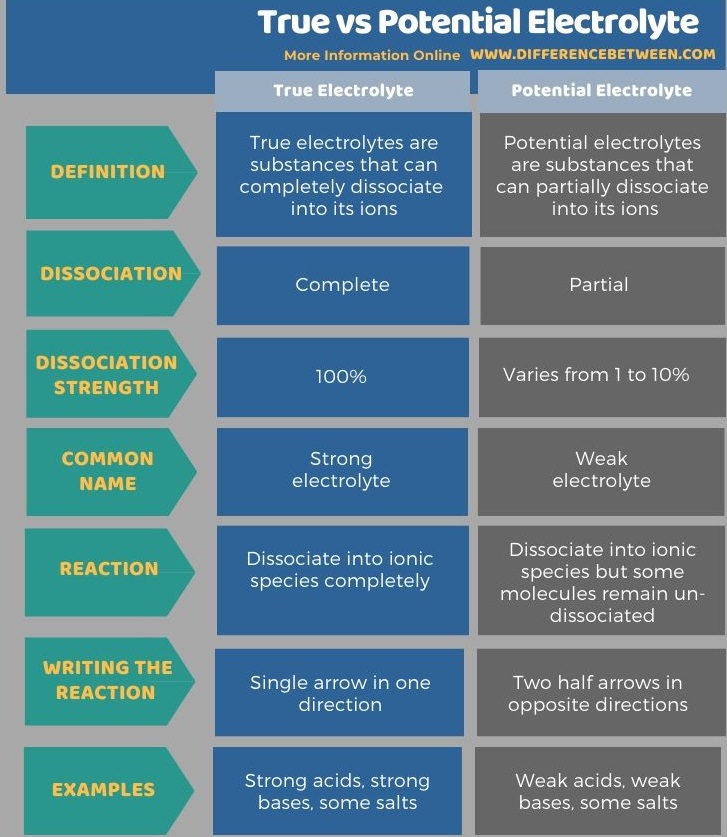Difference Between True and Potential Electrolyte
The key difference between true and potential electrolyte is that true electrolytes dissociate into ions completely whereas potential electrolytes dissociate into ions partially.
We can categorize all compounds into two groups as electrolytes and nonelectrolytes, depending on their ability to produce ions and conduct electricity. Electrolysis is the process of passing a current through an electrolytic solution and forcing positive and negative ions to move towards their respective electrodes. Nonelectrolytes cannot take part in electrolysis processes.
CONTENTS
1. Overview and Key Difference
2. What is True Electrolyte
3. What is Potential Electrolyte
4. Side by Side Comparison – True vs Potential Electrolyte in Tabular Form
5. Summary
What is True Electrolyte?
True electrolytes are the substance that can completely dissociate into its ions. These are also named as strong electrolytes. These compounds readily produce their ionic forms when dissolved in water or another solution. There are both cations and anions in the solution after the compound is dissociated; thus, these ions can carry electric current through the electrolytic solution. This is the reason for its name “electrolyte”, meaning “ability to conduct electricity”.
A concentrated solution of a true electrolyte has a low vapour pressure than pure water at a similar temperature. Strong acids, strong bases, soluble ionic salts that are not weak acids and bases can be classified as true electrolytes.

Figure 01: Complete Dissociation
When writing the chemical reaction for the ionization of a true electrolyte, we can use a single arrow in one direction to show the complete ionization reaction in contrast to potential or weak electrolytes. This single arrow means that the reaction occurs completely. True electrolytes can conduct electricity only when in molten or solutions state. Since the ionization is high, the voltage that a true electrolyte can produce is very high.
What is Potential Electrolyte?
Potential electrolytes are the substances that can partially dissociate into its ions. This means it cannot completely dissociate into its ions in an aqueous solution. Therefore, the aqueous solution of a potential electrolyte will contain both ionic species and un-dissociated molecules. Usually, the dissociation of a potential electrolyte is about 1-10%. These are also named as weak electrolytes. Some common examples of weak electrolytes include acetic acid, carbonic acid, ammonia, phosphoric acid, etc. These are either weak acids or weak bases.

Figure 02: Chemical Reaction for the Dissociation of Acetic Acid
When writing the chemical reaction for the dissociation of a weak electrolyte, we use two half arrows directing to opposite directions. This arrow means there is an equilibrium between the ionic species and unionized molecules in the aqueous solution.
What is the Difference Between True and Potential Electrolyte?
Depending on their ability to produce ions and conduct electricity, we can categorize all compounds into two groups as electrolytes and nonelectrolytes. Electrolytes again are divided into two parts as true and potential electrolytes. The key difference between true and potential electrolyte is that true electrolytes dissociate into ions completely whereas potential electrolytes dissociate into ions partially. Moreover, the dissociation strength of true electrolytes is 100% while the dissociation strength of potential electrolytes varies from 1 to 10%.
The following table summarizes the difference between true and potential electrolyte.

Summary – True vs Potential Electrolyte
True electrolytes are the substance that can completely dissociate into its ions while potential electrolytes are the substances that can partially dissociate into its ions. Therefore, the key difference between true and potential electrolyte is that true electrolytes dissociate into ions completely, whereas potential electrolytes dissociate into ions partially.
Reference:
1. Helmenstine, Todd. “Weak Electrolyte Definition and Examples.” ThoughtCo, Feb. 11, 2020, Available here.
Image Courtesy:
1. “Heterolysis (Chemistry)” By Jürgen Martens (CC BY-SA 3.0) via Commons Wikimedia
2. “Acetic-acid-dissociation-2D” By Ben Mills – Own work (Public Domain) via Commons Wikimedia
ncG1vNJzZmivp6x7pbXFn5yrnZ6YsqOx07CcnqZemLyue8OinZ%2Bdopq7pLGMm5ytr5Wau27A0a6cZpmemXqxu9Oepa2hkaF6prjEnKurp5yuwaZ7